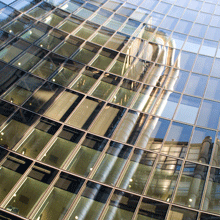 |
| Fibre optic technology offers the most efficient means of transmitting video in the digital environment |
Fulfilling the needs of modern IP surveillance systems
The advent of IP cameras has led to the development of a true digital video solution. The capacity needs and data-rich nature of digitised video almost certainly require that it be a large computer network that takes full advantage of the very best the field of information technology has to offer. Responding to the need for additional bandwidth, 10 gigabit networks are becoming more common. The IEEE specification relies predominantly on fibre optics. But even beyond fibre-based systems, the array of available products has expanded to encompass IP-based networking technologies that extend the capabilities of modern digital video systems.
For all its apparent complexity, a computer network is really a simple thing: a group of electronic devices and the links that connect them. Computer networks perform a critical mission in the security industry; therefore, the highest level of control and supervision must be achieved to keep the network functioning optimally. Supervising the components of the network is vital, whether it's the network infrastructure or the electronic devices - the security cameras, switches, servers, etc. -- that are the nodes on the network.
Security is really about event management and control, and a secure enterprise is possible only if it is protected by a security system whose infrastructure is secure |
The security industry requires real-time assurance that the network is functioning correctly, and real-time information and diagnostics if an event requires action. Technology can ensure supervision of each component of the network, thus protecting the network's overall integrity. The important mission of corporate security demands continuous, dependable network functionality. Security is really about event management and control, and a secure enterprise is possible only if it is protected by a security system whose infrastructure is secure.
Therefore, system designers need the tools necessary to monitor the network appliances and the network infrastructure itself. Ideally they need a video surveillance network solution that delivers control, management, infrastructure supervision and transmission capabilities specifically for professional security applications.
 |
| A secure enterprise is possible only if it is protected by a security system whose infrastructure is secure |
Technology and fibre expertise lead the way
Fibre optic technology offers the most efficient means of transmitting video in the digital environment, and the proliferation of video surveillance ensures its expanding role in security systems of the future. Today's security professionals need technology and expertise that extend beyond a specific product types. Fortunately, there has been a rapid evolution in transmission technologies and companies have expanded their expertise in solutions that address the specific communication methods employed in IP networks.
Network switches, com room supervisory appliances and event management software systems have joined fibre optic media converters to ensure reliable, mission critical transmission solutions. Networks that work together dependably and observably are critical to the future of the security technology industry. By catering to the specific needs of security and digital video surveillance, they can empower system integrators and users to make the all-important fibre-to-IP video connection.
| Jack Fernandes President and CEO American Fibertek |